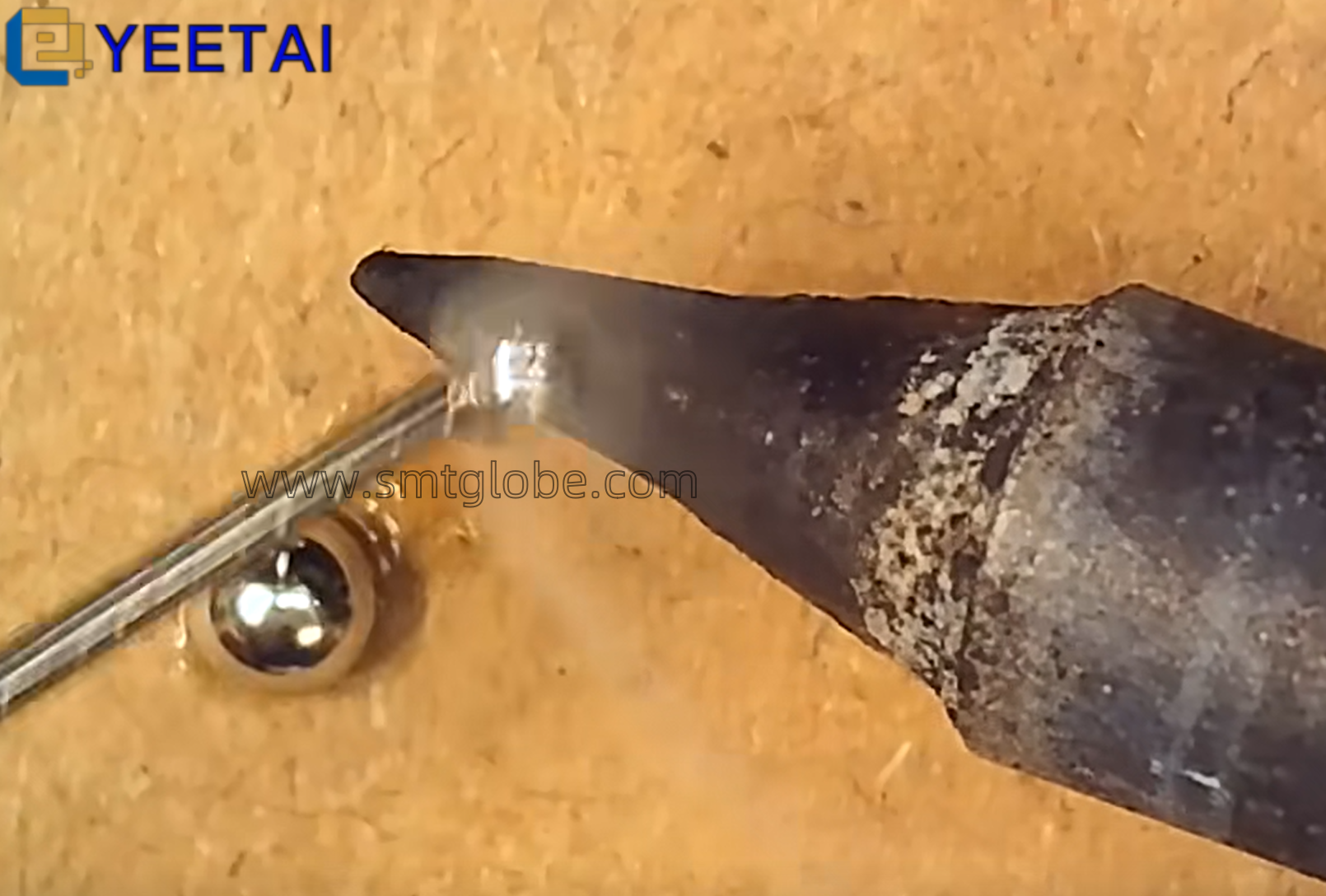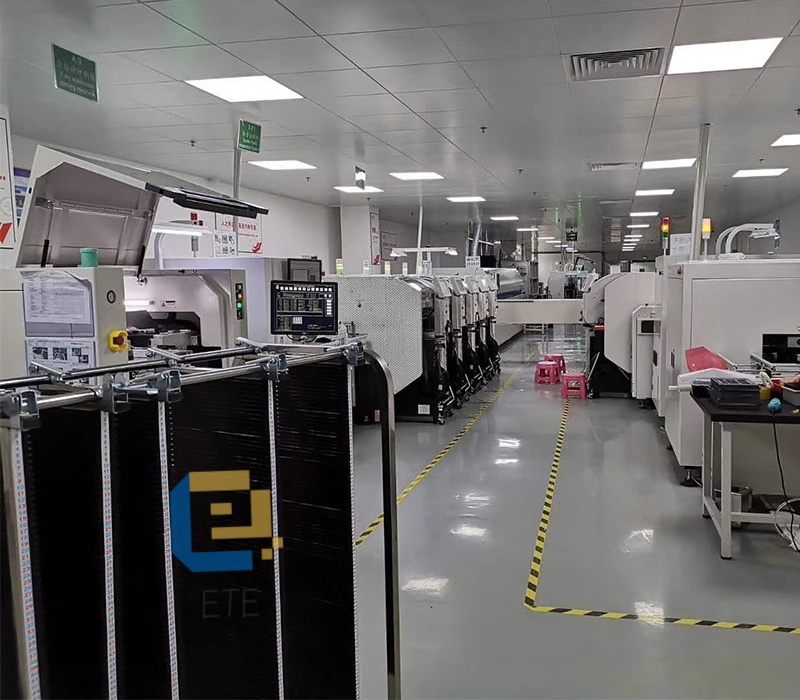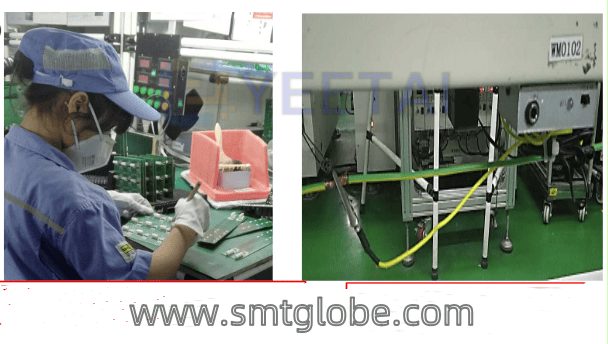ESD Static Protection Methods and Grounding Techniques
- Use of Anti-Static Materials:
Metals are conductors, and due to the high leakage current from conductors, they can damage components. In addition, insulating materials are prone to static buildup due to friction; therefore, neither metals nor insulating materials should be used as anti-static materials. Instead, materials with a surface resistance of less than 1 × 10^5 Ω•cm, known as static conductors, and those with surface resistance between 1 × 10^5 and 1 × 10^8 Ω•cm, called static dissipative materials, should be used. Common anti-static materials are often developed by mixing conductive carbon black into rubber, controlling the surface resistance to below 1 × 10^6 Ω•cm. - Leakage and Grounding:
Areas where static electricity might be generated or has already been generated should be grounded to provide a discharge pathway. This is achieved by establishing an “independent” ground line buried in the ground, ensuring that the resistance between the ground line and the earth is less than 10 Ω (refer to GBJ179 or SJ/T 10694—1996). - Grounding Methods for Anti-Static Materials:
Anti-static materials (such as work surface mats, floor mats, anti-static wrist straps, etc.) should be connected to a conductor leading to an independent ground line through a 1 MΩ resistor (refer to SJ/T 10630-1995). The 1 MΩ resistor is used to ensure the discharge current to the ground is less than 5 mA, which is referred to as a soft grounding method. The equipment enclosures and static shielding are typically directly grounded, known as hard grounding.
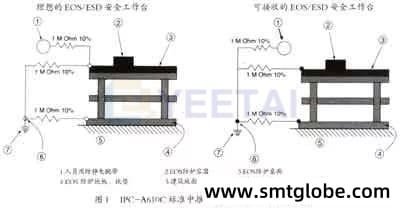
- Elimination of Static Electricity on Conductors:
The static electricity on conductors can be discharged to the ground through grounding methods. The voltage of the discharge body and the release time can be expressed by the following formula:
UT=U0L1/RC
Where:
- UT = Voltage at time T (V)
- U0 = Initial voltage (V)
- R= Equivalent resistance (Ω)
- C= Equivalent capacitance of the conductor (pF)
Generally, it is required to discharge static electricity within 1 second, bringing the voltage down to below 100V, which is considered a safe zone. This prevents excessive leakage rates and high leakage currents that could damage SSDs. For example, if U0=500V and C=200pF to achieve UT=100V within 1 second, Rmust be 1.28×109Ω. Therefore, a 1MΩ current-limiting resistor is typically used in static protection systems to keep the discharge current below 5mA, ensuring operational safety. If personnel accidentally come into contact with 220V industrial voltage while in the static protection system, it will not pose a danger.
- Elimination of Static Electricity on Non-Conductors:
For static electricity on insulators, since charges cannot flow on insulators, grounding methods cannot be used to eliminate static electricity. The following measures can be adopted:- 5.1 Use of Ion Blowers: Ion blowers generate positive and negative ions that can neutralize static electricity. They can be set up in the workspace and near the placement head of the mounting machine.
- 5.2 Use of Anti-Static Agents: Anti-static agents are surfactants that can be used to wipe down instruments and surfaces, quickly eliminating static electricity.
- 5.3 Control of Environmental Humidity: Increasing humidity can improve the surface conductivity of non-conductive materials, making it harder for static electricity to accumulate on surfaces. For instance, in dry northern environments, measures such as humidification and ventilation can be implemented.
- 5.4 Use of Electrostatic Shielding: For equipment prone to static electricity, shielding covers (cages) can be employed, which should be effectively grounded.
- Management and Maintenance of Anti-Static Work Areas:
- 6.1 Each workshop should have spare anti-static clothing, shoes, wrist straps, and other personal items for use by visitors.
- 6.2 Anti-static wrist straps should be checked daily.
- 6.3 The effectiveness of grounding for all anti-static equipment should be checked monthly.
- 6.4 The effectiveness of grounding for all anti-static work surface mats should be checked monthly and cleaned.
- 6.5 The anti-static performance of anti-static component racks, printed circuit board racks, transport boxes, trolleys, and floor mats should be checked every two quarters.
Usage and Inspection Methods for the ESD Protection System
- Precautions for Using Anti-Static Wrist Straps:
- 1.1 The wrist strap must have skin contact and should not be worn over clothing, gloves, or socks.
- 1.2 The metal part of the wrist strap should ideally be worn on the back of the hand (as shown in the diagram).
- 1.3 Daily inspections should be conducted, and work can only proceed after confirming it is OK.
- 1.4 When grounding, ensure the crocodile clip of the wrist strap is clamped onto the exposed copper section of the ground wire, not on the insulation (the ground wire is yellow).
- Inspection Method for Anti-Static Wrist Straps:
- 2.1 First, wear the anti-static wrist strap, ensuring the metal part makes full contact with the skin.
- 2.2 Then, clamp the other end of the wrist strap to the connection interface of the testing device (as shown in the diagram).
- 2.3 Press the circular aluminum button on the static tester; if the “GOOD” light on the tester lights up, it indicates an OK status (as shown in the diagram). If the red light “HIGH” is on, check if the connection wire is functioning properly and inspect if the wrist strap’s wiring is broken. If broken, please replace the wiring (as shown in the diagram). If the red light “LOW” is on, it indicates an abnormality or malfunction of the wrist strap, and the wrist strap should be replaced.
- 2.4 Record the inspection results on the “Anti-Static Wrist Strap Inspection Record Form,” marking “√” for qualified items and “×” for unqualified items in the corresponding fields.
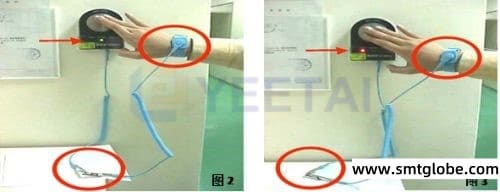
- Precautions for Anti-Static Clothing in the SMT Workshop:
- 3.1 All buttons must be fastened, sleeves should not be rolled up, and clothing must be clean and tidy.
- 3.2 Anti-static shoes, gloves, hats, and clothing must be washed once a month to maintain their anti-static effectiveness.
- 3.3 Hair must be completely tucked into the hat.
- Grounding Considerations for Equipment:
- 4.1 All equipment grounding wires should be green.
- 4.2 Equipment grounding wires must not be connected to human static grounding wires to prevent electric shock from equipment leakage.
- 4.3 Daily equipment inspections should include: soldering irons, televisions, computers, oscilloscopes, digital signal ports, DC power supplies, wave soldering machines, pick-and-place machines, reflow ovens, automatic lead cutters, flash programming devices, and all other auxiliary production equipment.
- Grounding Inspection Method for Equipment:
Use a multimeter set to the resistance testing mode. One probe should make good contact with the negative terminal of the equipment, and the other probe should contact the exposed copper section of the green grounding wire. Check the resistance value on the multimeter; if the grounding resistance is less than 10Ω, it is considered qualified. If it is out of range, it is deemed unqualified. Unqualified grounding wires should be promptly discarded and replaced with qualified grounding wires. - Inspection Method for Anti-Static Work Surface Mats:
Use a multimeter set to the resistance testing mode. One probe should make good contact with the grounding snap of the anti-static work surface mat, while the other probe should contact the exposed copper section of the yellow grounding wire. Check the resistance value on the multimeter; if the grounding resistance is within 1MΩ ± 10%, it is considered qualified. If it is out of range, it is deemed unqualified. Unqualified grounding wires should be promptly discarded and replaced with qualified grounding wires.
Anti-Static Inspection Methods in SMT Workshops
Detailed Anti-Static Inspection Rules for SMT Workshops:
- 2.1 All production equipment in the SMT workshop must be properly grounded, and pick-and-place machines should use a three-phase grounding method with independent grounding.
- 2.2 The floors and work surface mats in the production area should meet anti-static requirements.
- 2.3 The workshop should maintain a constant temperature and humidity environment.
- 2.4 Facilities should include anti-static material boxes, transport boxes, PCB racks, logistics carts, anti-static packaging tape, anti-static wrist straps, anti-static soldering irons, and tools.
- 2.5 Anti-static zones should be established according to anti-static requirements, with clear anti-static warning signs.
- 2.6 The static sensitivity of devices in the work area should be categorized into three levels (1, 2, and 3), and different protective measures should be formulated based on the sensitivity levels:
- Level 1: Static sensitivity range of 0-1999V
- Level 2: Static sensitivity range of 2000-3999V
- Level 3: Static sensitivity range of 4000-15999V
Above 16000V: Non-static sensitive products.
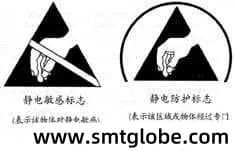
Regulations for the Anti-Static Safety Area
- 2.7 The room temperature in the anti-static safety area should be maintained at 25 ± 3°C, with a relative humidity of 35-70% RH. Operations involving SSDs (static-sensitive components) are prohibited in environments with humidity below 30%.
- 2.8 Non-production items, such as dining utensils, teapots, bags, woolen fabrics, newspapers, and rubber gloves, are not allowed on the workbench in the anti-static safety area.
- 2.9 All personnel must wear anti-static clothing, hats, and anti-static shoes before entering the pick-and-place room.
- 2.10 Before starting work, personnel must conduct inspections of their anti-static shoes and wrist straps. They may only proceed to their workstations once these items are confirmed to be qualified. (The anti-static testing equipment must be qualified and within its validity period.)
- 2.11 When handling products, anti-static gloves or finger cots must be worn.
- 2.12 When picking up PCBs, personnel should handle them by the edges and avoid touching the SSD components whenever possible.
- 2.13 For hand placements and visual inspections, take one piece from the pick-and-place machine or reflow oven for inspection, place it down immediately, and do not stack them on the table. Any PCB boards that fail inspection should be addressed promptly.
- 2.14 Inspection personnel should have a good understanding of electrostatic protection knowledge related to sensitive components.
DIP Insertion Soldering Testing Anti-Static Inspection Rules
- 3.1 All production equipment (including regular TVs, high-definition TVs, wave soldering machines, computers, automatic lead cutters, etc.) must be properly grounded.
- 3.2 The workbench mats in the production area must meet anti-static requirements.
- 3.3 Constant temperature soldering irons must be effectively grounded.
- 3.4 Facilities should include anti-static material boxes, transport boxes, PCB racks, logistics carts, anti-static wrist straps, anti-static soldering irons, and tools.
- 3.5 Anti-static wrist straps must be worn during operations, and their effectiveness should be measured daily.
- 3.6 When handling PCBs, personnel should grasp them by the edges and avoid touching SSD components whenever possible.
Requirements for ESD Protective Equipment and Sensitive Component (SSD) Handling, Storage, and Use
1. ESD Protective Equipment
- 1.1 The human ESD protection system includes anti-static wrist straps, work clothes, hats, gloves, shoes, and socks.
- 1.2 ESD flooring includes anti-static terrazzo flooring, anti-static rubber flooring, PVC anti-static plastic flooring, anti-static carpets, and anti-static movable flooring.
- 1.3 The series of anti-static operations includes anti-static workbench mats, anti-static packaging bags, anti-static logistics carts, and anti-static soldering irons and tools.
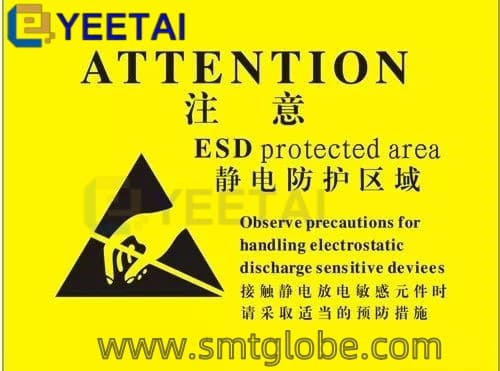
Requirements for the Transportation, Storage, and Use of Static-Sensitive Components (SSDs)
- Transportation: SSDs must not be dropped or removed from their packaging during transportation.
- Storage Conditions: The relative humidity in the storage area for SSDs should be maintained at 30-40% RH.
- Packaging: SSDs should remain in their original packaging during storage. If repackaging is necessary, use containers with anti-static properties.
- Labeling: Anti-static labels should be affixed to the locations designated for SSD components in the storage area.
- Counting: When issuing SSD components, visually count the quantity within the original packaging.
- Flash Operations: When performing write, erase, or information protection operations on flash devices, ensure that the writing or erasing equipment is properly grounded, and wear anti-static wrist straps.
- Operational Compliance: Personnel involved in assembly, soldering, board repairs, and debugging must strictly adhere to static protection requirements.
- Final Testing: Printed circuit boards that have passed inspection should be ion-blasted with an ionizing blowgun before packaging to eliminate any potentially accumulated static charge.

